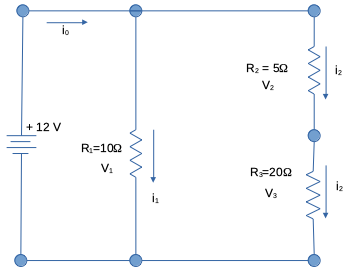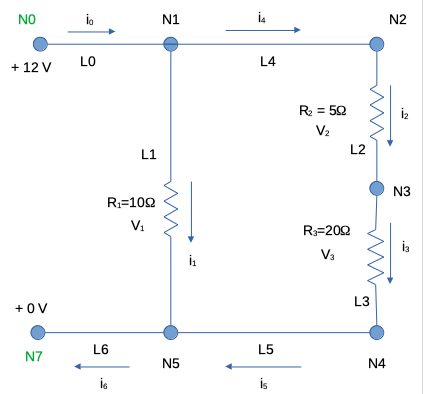Applications - Electronic Circuit Analysis¶
Solving a Circuit (using Linear Algebra)¶
Suppose we wish to analyze the electric circuit in Fig. 2.

Fig. 12 Caption¶
In this example, identical to the earlier example, we will employ a few tricks to generalize the solution for nearly any resistor network in a DC circuit. The actual result is a modification of an algorithm presented by Haman and Braemiller (CITE). Applying the problem solving protocol might be something like
Step 1: Problem Statement¶
Determine the unknown parameters that characterize the behavior of the circuit depicted in Fig. 2.
Step 2: Sketch the Situation¶
To employ the linear-system approach of Haman and Braemiller (CITE) we will need to redraw the sketch a bit as

Fig. 13 Caption¶
Step 3: List Known and Unknown Values¶
Known:
Circuit topology (configuration) and component relative locations.
Source voltage: +12 volts as shown on the diagram.
Resistor values: \(R_1=~10 \Omega\) , \(R_2=~5 \Omega\) , \(R_3=~20 \Omega\)
Unknown:
The current in different parts of the circuit: \(i_0\) , \(i_1\) , \(i_2\) .
The voltage drops (differences) across each resistor: \(V_1\) , \(V_2\) , \(V_3\) .
Step 4: Identify Governing Principles¶
Ohm’s law: The voltage drop across a resistor is the product of current frowing through the resistor and the resistance; \(V=IR\) .
Kirchoff’s Law - Resistors in Series; \(R_T=R_1 + R_2 + \dots+ R_n\)
Kirchoff’s Law - Resistors in Parallel; \(R_T=\frac{1}{\frac{1}{R_1} + \frac{1}{R_2} + \dots+ \frac{1}{R_n}}\)
We don’t actually need Kirchoff’s Law in the method we will employ, mostly just Ohm’s law and continunity of current at a node. We will solve for voltages at each node, and currents in each link.
Step 5: Analysis¶
Different from the last time we examined this problem, we will simply write continunity of charge at each node:
\(\sum i_{inflow} - \sum i_{outflow} = 0\) at each node (note if we have capicators and/or inductors, then there is a storage term and the system is no longer at equilibrium). So we will end up with one equation for each interior node (Node 0 and Node 7 have known voltages).
For example for Node 1:
\(i_0 - i_1 - i_4 = 0\) is the current balance equation for the node.
Next we will implement Ohm’s law for each link; for example for Link 1:
\(V_1 - R_1 i_1 -V_5 = 0\)
Next simply organize these into a system of equations and solve. For this example the equation system looks like:
Where the link resistances are set to a small, but non-zero value to preserve the non-singularity of the coefficient matrix, except for links with known resistances, and the known node voltages appear in the RHS vector.
Step 6 Implementing a solver in the Jupyter Notebook¶
First we will prototype in Jupyter Lab and explicitly enter the matrix coefficients and right-hand-side. Once we recognize the node-arc pattern, we can modify our script to operate on just a minimal description supplied by an external datafile.
import numpy
nnodes = 5
nlinks = 6
R0 = 0.00001 # small but non-zero to prevent singular matrix
R1 = 10.0
R2 = 5.0
R3 = 20.0
R4 = 0.00001 # small but non-zero to prevent singular matrix
R5 = 0.00001 # small but non-zero to prevent singular matrix
R6 = 0.00001 # small but non-zero to prevent singular matrix
# [i0, i1, i2, i3, i4, i5, i6, v1, v2, v3, v4, v5]
amatrix = [[ 1, -1, 0, 0, -1, 0, 0, 0, 0, 0, 0, 0],
[ 0, 0, -1, 0, 1, 0, 0, 0, 0, 0, 0, 0],
[ 0, 0, 1, -1, 0, 0, 0, 0, 0, 0, 0, 0],
[ 0, 0, 0, 1, 0, -1, 0, 0, 0, 0, 0, 0],
[ 0, 1, 0, 0, 0, 1, -1, 0, 0, 0, 0, 0],
[-R0, 0, 0, 0, 0, 0, 0, -1, 0, 0, 0, 0],
[ 0,-R1, 0, 0, 0, 0, 0, 1, 0, 0, 0, -1],
[ 0, 0,-R2, 0, 0, 0, 0, 0, 1, -1, 0, 0],
[ 0, 0, 0,-R3, 0, 0, 0, 0, 0, 1, -1, 0],
[ 0, 0, 0, 0,-R4, 0, 0, 1, -1, 0, 0, 0],
[ 0, 0, 0, 0, 0,-R5, 0, 0, 0, 0, 1, -1],
[ 0, 0, 0, 0, 0, 0,-R6, 0, 0, 0, 0, 1]]
rhsvector = [0,0,0,0,0,-12,0,0,0,0,0,0]
# use numpy for the linear algebra
A = numpy.array(amatrix)# numpy the A matrix
b = numpy.array(rhsvector)# numpy the b vector
x = numpy.linalg.solve(A,b) # solve the linear system, x marks the spot
# debug
#for i in range(len(amatrix)):
# print(amatrix[i],rhsvector[i],round(x[i],3))
print("--------Node Voltages--------")
for i in range(1,nnodes+1,1):
print("Voltage at Node",i," is ",round(x[nlinks+i],3)," Volts")
print("--------Link Currents--------")
for i in range(0,nlinks+1,1):
print("Current in Link ",i," is ",round(x[i],3)," Amperes")
--------Node Voltages--------
Voltage at Node 1 is 12.0 Volts
Voltage at Node 2 is 12.0 Volts
Voltage at Node 3 is 9.6 Volts
Voltage at Node 4 is 0.0 Volts
Voltage at Node 5 is 0.0 Volts
--------Link Currents--------
Current in Link 0 is 1.68 Amperes
Current in Link 1 is 1.2 Amperes
Current in Link 2 is 0.48 Amperes
Current in Link 3 is 0.48 Amperes
Current in Link 4 is 0.48 Amperes
Current in Link 5 is 0.48 Amperes
Current in Link 6 is 1.68 Amperes
